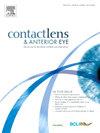Corneal astigmatism after temporary discontinuation from long-term spherical and toric orthokeratology
IF 4.1
3区 医学
Q1 OPHTHALMOLOGY
引用次数: 0
Abstract
Objective
To investigate changes in corneal astigmatism (curvatures and corneal sagittal height difference (C-sagDiff) at 8-mm chord) after temporary discontinuation from long-term spherical and toric orthokeratology (ortho-k) lens wear in a Chinese population.
Methods
Relevant data were retrieved from 110 patients (55 wearing spherical ortho-k lenses, 55 wearing toric ortho-k lenses) who have been undergoing ortho-k treatment for at least one year and stopped lens wear temporarily for scheduled lens replacement. The topographic and refraction data at baseline and post-discontinuation was collected for all the patients. Only data from the right eye was used for analysis. Corneal curvature changes and C-sagDiff at 8-mm chord in the two principal meridians within each group and the corneal astigmatism changes between the two groups were analyzed.
Results
No significant differences in age, gender, baseline flat K (FK) and steep K (SK), myopia, refractive astigmatism, and duration of lens wear were noted between the two groups (P > 0.05). Baseline corneal astigmatism and C-sagDiff in toric ortho-k group was higher than spherical ortho-k group (P < 0.001). For both ortho-k groups, after treatment discontinuation of about 1-month (30–37 days), FK became flatter, SK remained unchanged, corneal astigmatism and C-sagDiff increased. Changes in corneal astigmatism for spherical and toric groups were 0.24 ± 0.33 and 0.32 ± 0.32 D, respectively. C-sagDiff increased from 22.85 ± 8.41 to 31.37 ± 12.98 μm and from 32.35 ± 12.39 to 45.40 ± 15.01 μm in the spherical and toric ortho-k groups, respectively. No significant between-group difference in corneal astigmatism change was found (P = 0.214). Corneal astigmatism change was affected by wearers’ age and duration of ortho-k lens wear. The younger the subject and the longer the duration of ortho-k lens wear, the more significant the corneal astigmatism change after discontinuation of the treatment.
Conclusion
After 1-month discontinuation from long-term ortho-k lens wear, corneal flat K became flatter, steep K remained unchanged, the C-sagDiff and the corneal astigmatism increased, irrespective of whether spherical or toric lenses were used. The change of corneal astigmatism was about 0.25D on average, which was not clinically significant. There was no significant difference of corneal and refractive astigmatism change between spherical and toric ortho-k groups.
暂时停止长期球形和环形角膜塑形术后的角膜散光。
目的:探讨中国人群暂时停止长期球形和环形角膜塑形镜配戴后角膜散光(曲率和角膜矢状高度差(C-sagDiff)在8毫米弦处)的变化。方法:选取110例(55例配戴球面矫视k镜片,55例配戴圆环矫视k镜片)接受矫视k治疗至少1年,暂时停止配戴晶状体进行预定的晶状体置换的患者。收集所有患者基线和停药后的地形和折射数据。仅使用右眼的数据进行分析。分析各组两主经络8mm弦处角膜曲率变化、C-sagDiff及两组角膜散光变化。结果:两组患者在年龄、性别、基线平、陡K、近视、屈光散光、晶状体磨损时间等方面差异均无统计学意义(P < 0.05)。结论:停用长期配镜1个月后,无论使用球面还是环面镜片,角膜平K变平,陡K不变,C-sagDiff和角膜散光均增加。角膜散光变化平均约0.25D,无临床意义。球面矫正k组与环面矫正k组角膜屈光散光变化无显著差异。
本文章由计算机程序翻译,如有差异,请以英文原文为准。
求助全文
约1分钟内获得全文
求助全文
来源期刊

Contact Lens & Anterior Eye
OPHTHALMOLOGY-
CiteScore
7.60
自引率
18.80%
发文量
198
审稿时长
55 days
期刊介绍:
Contact Lens & Anterior Eye is a research-based journal covering all aspects of contact lens theory and practice, including original articles on invention and innovations, as well as the regular features of: Case Reports; Literary Reviews; Editorials; Instrumentation and Techniques and Dates of Professional Meetings.
 求助内容:
求助内容: 应助结果提醒方式:
应助结果提醒方式:


